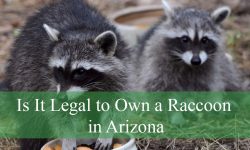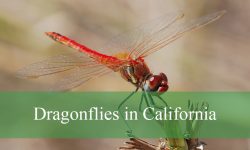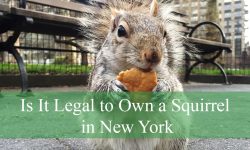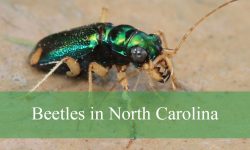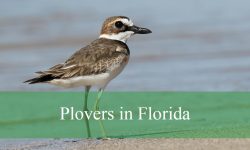Florida is home to a dazzling variety of ladybugs, also known as ladybird beetles. These tiny, colorful insects are more than just charming — they’re hardworking pest controllers that help keep gardens and crops healthy. From bright red and orange to shiny black and even metallic blue, Florida’s ladybugs come in a stunning range of colors and patterns.
Thanks to the state’s warm, humid climate, both native and introduced species thrive year-round. You can find them almost anywhere — crawling on garden plants, resting on citrus trees, or hunting aphids in wildflower meadows. Each species has its own unique appearance and preferred habitat.
In this guide, we’ll explore 12 of the most common types of ladybugs found across Florida. You’ll learn how to identify them, where they live, and what makes each one an important part of the local ecosystem.
Common Types of Ladybugs Found in Florida
Seven-Spotted Lady Beetle (Coccinella septempunctata)
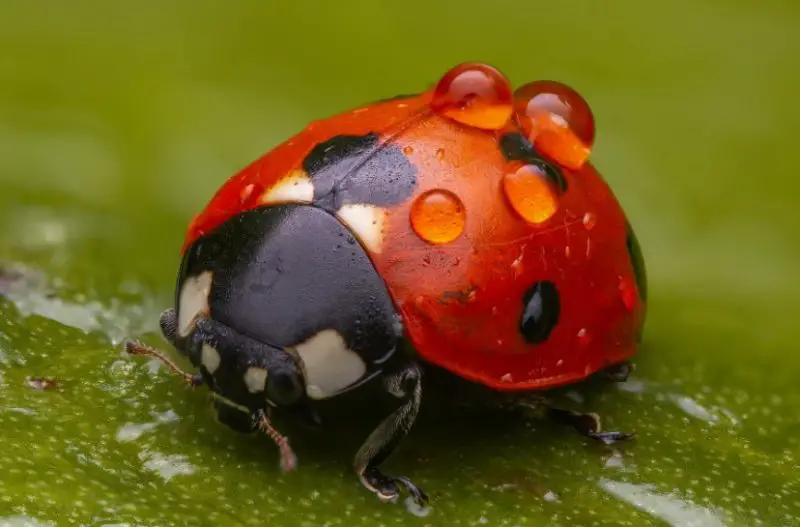
The Seven-Spotted Lady Beetle is one of the most recognizable and iconic ladybug species in the world. Its bright red wing covers, adorned with seven distinct black spots—three on each side and one centered on the back—make it easy to identify. The beetle’s body is dome-shaped and about 7–8 millimeters long, with a glossy finish that catches sunlight beautifully. Its black head and pronotum contrast sharply with the vibrant red elytra, giving it a striking appearance.
Originally native to Europe, this species was introduced to North America as a natural form of pest control. In Florida, it has adapted well to the warm, humid environment, where it thrives in gardens, fields, and citrus orchards. It can be seen resting on plant leaves or crawling across flower petals in search of prey, particularly during spring and summer.
The Seven-Spotted Lady Beetle is a voracious predator, feeding primarily on aphids, scale insects, and small caterpillars. Both adults and larvae play a vital role in reducing pest populations on ornamental plants and crops. Their feeding habits make them one of the most beneficial insects for Florida’s agricultural ecosystems.
These ladybugs prefer open, sunny areas with plenty of flowering plants, where they can hunt and lay eggs. While they are active throughout the year in southern Florida, they may slow down during cooler months in the north. Their resilience and adaptability have allowed them to establish strong populations across the state.
Convergent Lady Beetle (Hippodamia convergens)
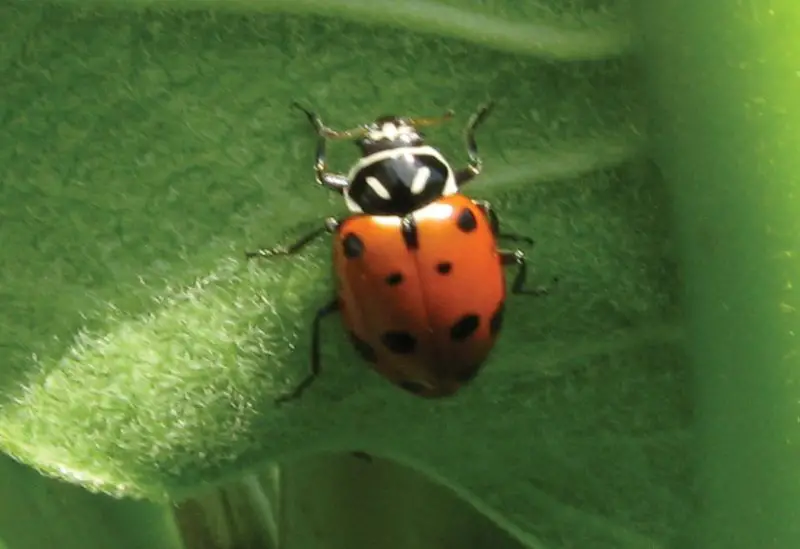
The Convergent Lady Beetle is one of North America’s most familiar native species and is instantly recognized by the two white lines that “converge” on its pronotum. Its wing covers are bright orange to red with 13 small black spots that vary slightly among individuals. Slightly smaller than the Seven-Spotted Lady Beetle, it measures around 6 mm and has an oval, smooth shape.
This species has a long history of use in agriculture as a biological control agent. It’s widely released by farmers and gardeners to manage pest infestations naturally, reducing the need for chemical pesticides. In Florida, the Convergent Lady Beetle thrives in citrus groves, farmlands, parks, and gardens, where aphids and whiteflies are plentiful.
Adult beetles and their larvae are highly efficient hunters. They primarily feed on aphids, mites, and small insect eggs, helping protect crops and ornamentals from damage. They can consume hundreds of aphids in their lifetime, making them valuable natural allies in maintaining ecological balance.
These ladybugs are most active during spring and early summer when prey populations peak. They are often seen congregating in groups on plant stems or leaves. Their bright color, energetic behavior, and role as beneficial predators make them a favorite among both farmers and nature enthusiasts in Florida.
Asian Lady Beetle (Harmonia axyridis)
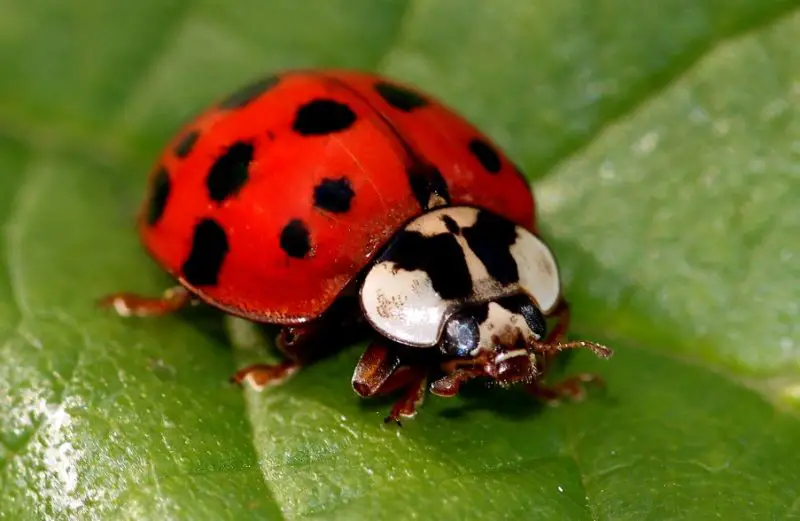
The Asian Lady Beetle is a highly variable and adaptable species that can be found in an impressive array of colors—from pale yellow to deep orange-red. The number of spots on its back can range from none to as many as nineteen. A defining feature that sets it apart from other species is the black “M” or “W” pattern on its pronotum, depending on the viewing angle.
Introduced from Asia in the late 20th century to help control aphid populations, this beetle quickly spread across the United States, including all of Florida. Its adaptability allows it to thrive in a wide variety of environments, from gardens and forests to urban areas. It is now one of the most common ladybugs seen throughout the state.
Asian Lady Beetles are aggressive hunters that feed on aphids, scale insects, and other soft-bodied pests. However, their competitive nature has caused concern among scientists because they sometimes displace native ladybug species. Despite this, they remain highly effective natural pest controllers in Florida’s gardens and agricultural fields.
While beneficial outdoors, Asian Lady Beetles are also known for their tendency to invade homes during cooler weather. They gather in large numbers on walls, window frames, and attics seeking warmth and shelter. Though harmless, their presence indoors can be a nuisance for homeowners across Florida during fall and winter.
Twice-Stabbed Lady Beetle (Chilocorus stigma)
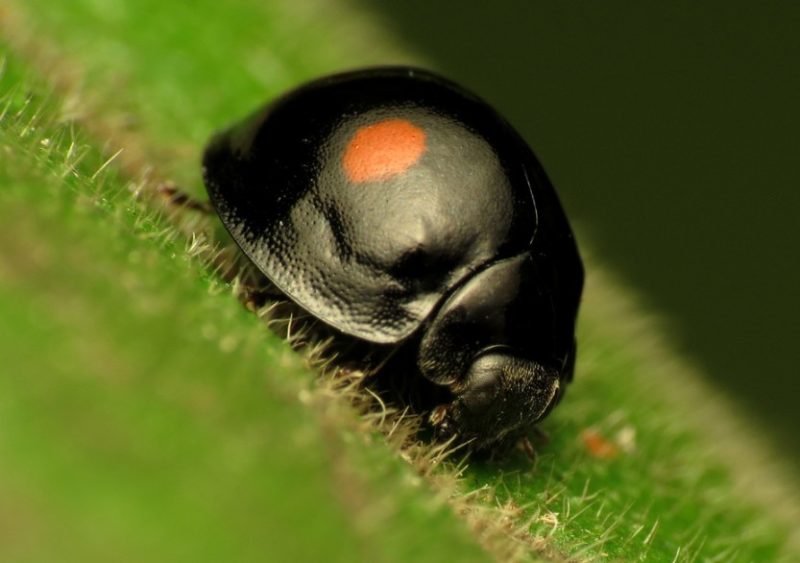
The Twice-Stabbed Lady Beetle is one of Florida’s most visually distinct and useful native species. It has a small, glossy black, dome-shaped body with two bright red circular spots—one on each wing cover. This vivid contrast makes it appear as though it’s been “stabbed” twice, which inspired its common name. It’s smaller than many other ladybugs, averaging just 4 millimeters in length.
Unlike most red or orange ladybugs, this species’ dark coloration helps it blend into shaded areas and tree bark. It’s often found in citrus orchards, oak trees, and on ornamental plants where scale insects thrive. Its tiny size and dome-shaped body allow it to crawl into crevices where pests hide.
The Twice-Stabbed Lady Beetle specializes in feeding on scale insects and aphids, making it a vital component of Florida’s natural pest control network. Both adult beetles and larvae are highly effective at reducing pest populations on woody plants, which helps maintain the health of trees and shrubs.
This hardy species is active throughout the year in Florida’s mild climate and is well adapted to both rural and urban environments. It can often be spotted on plant stems after rain showers, hunting for prey or laying eggs on infested leaves. Its steady population and efficiency make it a favorite among citrus growers and gardeners alike.
Spotless Lady Beetle (Cycloneda sanguinea)
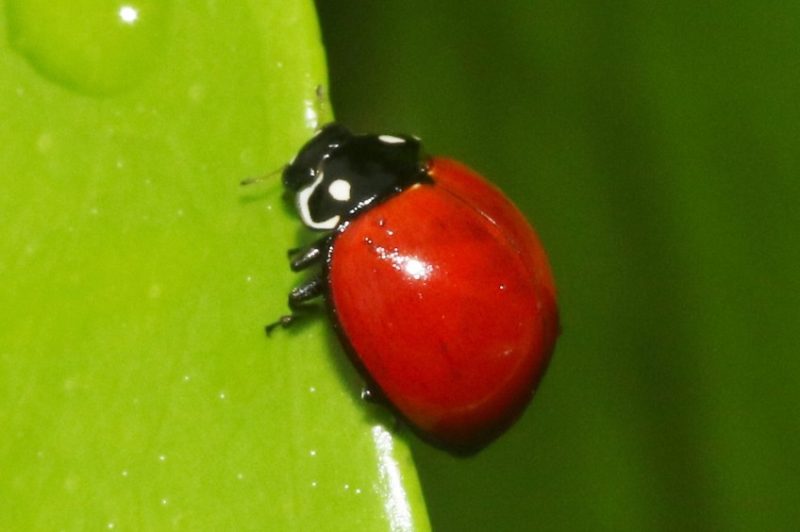
The Spotless Lady Beetle stands out for its clean, bright appearance and lack of black markings on its red or orange wing covers. Its head and pronotum are black with striking white markings, giving it a sharp, polished look. The species’ name, sanguinea, refers to its blood-red color, a vivid hue that glows under Florida sunlight.
This species is native to the Americas and is one of the most widespread ladybugs in Florida. It thrives in warm, humid environments and is frequently found near milkweed, sunflowers, and vegetable gardens. Its preference for lush vegetation and aphid-rich habitats makes it common in both wild and cultivated areas.
Adult Spotless Lady Beetles are aggressive aphid hunters, consuming dozens each day. Their larvae, which resemble tiny alligators, are equally effective predators. They help control pests naturally, reducing the need for insecticides and promoting healthier plant growth. Their presence is a sign of a balanced garden ecosystem.
In Florida, this species is active year-round due to the favorable climate. They are most numerous during spring and summer, especially after rainfall when aphid populations surge. Their vibrant color, elegant simplicity, and ecological importance make the Spotless Lady Beetle a beloved and beneficial resident of Florida’s gardens and fields.
Ashy Gray Lady Beetle (Olla v-nigrum)
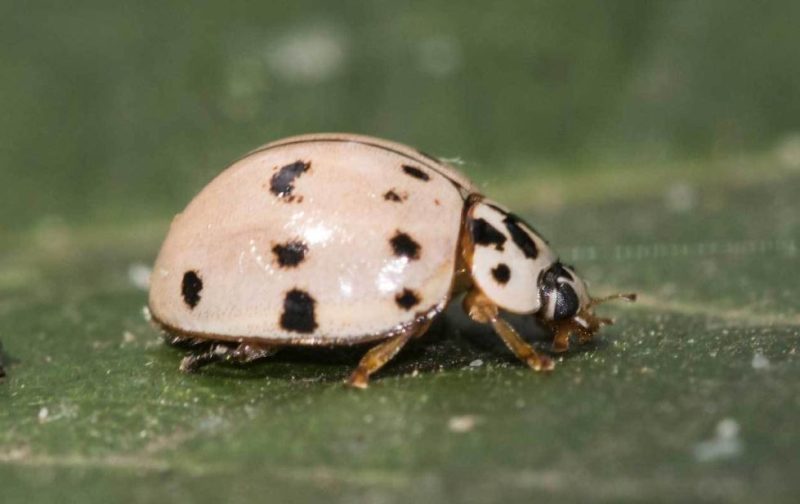
The Ashy Gray Lady Beetle is a distinctive species easily recognized by its unique coloration. It has two main color forms: one gray with small black spots and another orange with black markings. The gray morph, which is more common in shaded areas, has a powdery or dusty appearance that provides natural camouflage on tree bark and leaves. Its compact, rounded body measures about 5–6 millimeters in length.
This species can be found across Florida in a wide range of habitats, including woodlands, gardens, orchards, and even citrus groves. It’s particularly common in areas where aphids and scale insects are abundant. The Ashy Gray Lady Beetle’s ability to thrive in both cultivated and natural landscapes has made it a well-established resident of the state.
An efficient predator, this ladybug feeds primarily on aphids, mealybugs, and scale insects that infest trees and ornamental plants. Its larvae are equally effective hunters, often found crawling along plant stems searching for soft-bodied prey. Because of its adaptability, it plays a key role in maintaining pest balance across various ecosystems.
Unlike most ladybug species that are primarily active during the day, the Ashy Gray Lady Beetle remains active at dusk as well. This extended hunting period increases its effectiveness as a natural pest control agent. Its ability to blend in and continue foraging even under low light conditions makes it a quiet but powerful ally in Florida’s agricultural and garden environments.
Fifteen-Spotted Lady Beetle (Anatis labiculata)
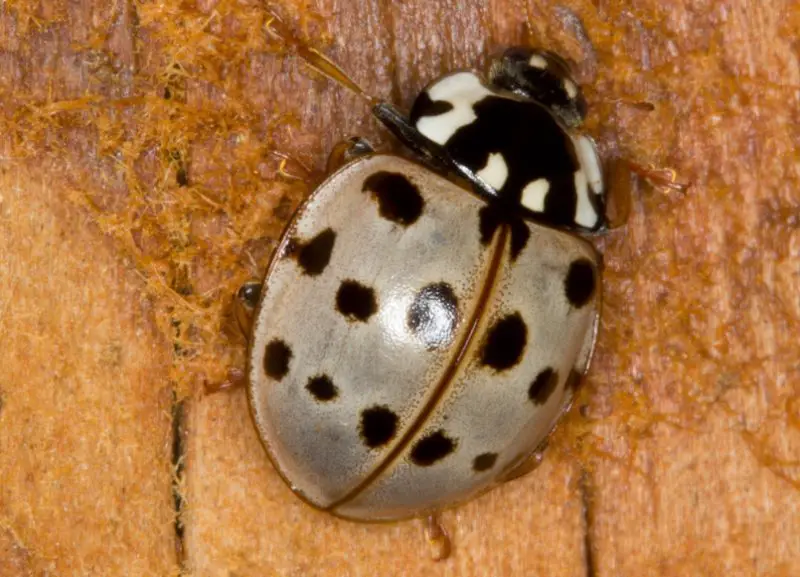
The Fifteen-Spotted Lady Beetle is a striking and relatively large species known for its pale orange to pinkish wing covers marked with fifteen bold, black spots. Its pronotum features white edges and distinct black markings that give it a collared or shield-like appearance. This combination of size and pattern makes it one of the most elegant ladybugs seen in Florida.
Although not as common as some smaller species, it can be spotted in the northern and central regions of Florida, especially in wooded areas and forest edges. It prefers cooler, shaded habitats and often resides on trees or shrubs where its favorite prey—aphids—are abundant. During spring, it’s frequently seen patrolling the leaves of pines, maples, and oaks.
Both adults and larvae are voracious aphid eaters, contributing significantly to pest control in forested and semi-rural environments. The larvae have spiny, elongated bodies and are just as aggressive in feeding as the adults, consuming hundreds of aphids over their development. This makes the Fifteen-Spotted Lady Beetle an important natural regulator of aphid populations on trees.
Because of its larger size, this species can tolerate a wider range of environmental conditions compared to smaller ladybugs. Its presence in Florida’s diverse habitats highlights its adaptability. While less frequently seen than other species, each encounter is memorable due to its bold appearance and ecological importance.
Mealybug Destroyer (Cryptolaemus montrouzieri)
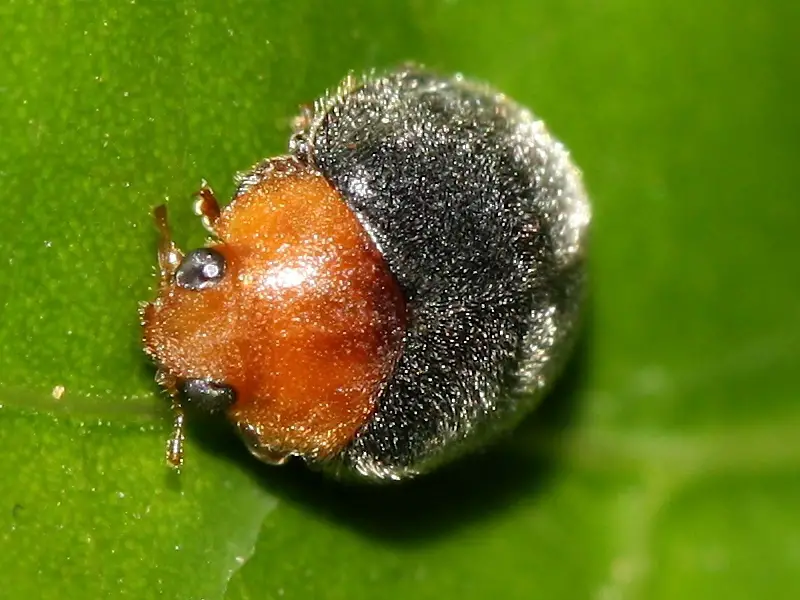
The Mealybug Destroyer is one of the most specialized ladybugs found in Florida. Its body is dark brown with an orange head and legs, giving it a striking two-toned look. Measuring about 4 millimeters long, this species lacks the typical bright red and black coloration associated with ladybugs. Despite its modest appearance, it’s among the most valuable biological control agents in agriculture.
Originally from Australia, the Mealybug Destroyer was introduced to the United States to help control mealybug infestations, especially in citrus orchards and greenhouses. In Florida, it has become well-established thanks to the subtropical climate that supports its prey. It’s commonly seen in citrus groves, ornamental plantings, and indoor cultivation facilities.
Both adult and larval Mealybug Destroyers feed exclusively on mealybugs. The larvae are particularly interesting because they resemble mealybugs themselves—covered in white waxy filaments that allow them to blend in among their prey. This mimicry provides protection while they feed, making them exceptionally efficient at eliminating infestations.
This species is active year-round in Florida and is often released commercially by growers as a natural pest control method. It’s especially valued for its ability to manage outbreaks without the use of harmful chemicals. The Mealybug Destroyer’s specialized diet and effectiveness make it a cornerstone of sustainable pest management in the state.
Three-Banded Lady Beetle (Coccinella trifasciata)
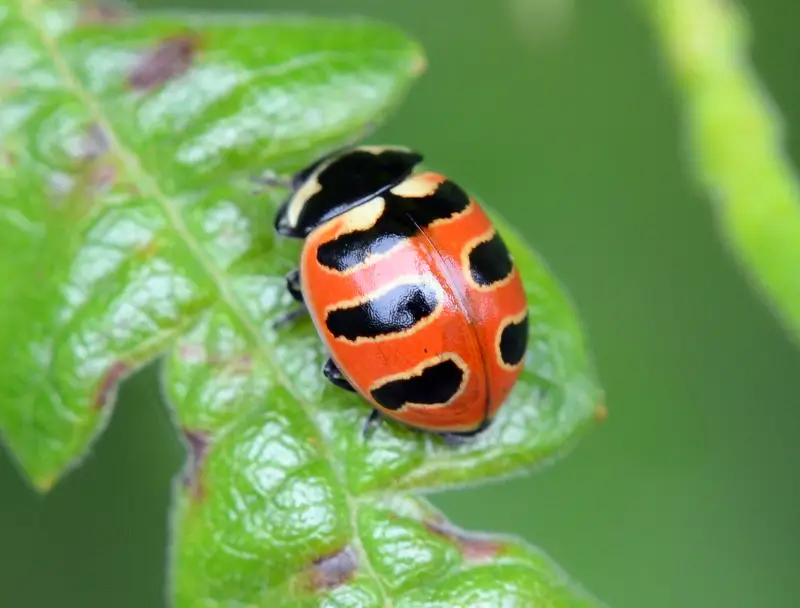
The Three-Banded Lady Beetle is easily identified by its distinctive pattern—three bold, curved black bands stretching across its red or orange wing covers. Unlike spotted species, its striped appearance sets it apart, making it one of the more visually striking ladybugs found in Florida. It has a compact, oval body about 5–6 millimeters long and a glossy finish that gleams under sunlight.
This species inhabits a variety of environments including gardens, grasslands, and meadows. In Florida, it’s especially common in agricultural regions and along wildflower-filled roadsides where aphids flourish. Its adaptability allows it to thrive in both cultivated and wild habitats, from the Panhandle to the southern peninsula.
The Three-Banded Lady Beetle is an active predator of aphids, thrips, and small insect eggs. Its larvae, black with orange markings, are fierce hunters that play a crucial role in controlling pest outbreaks. Both life stages are important in maintaining natural pest suppression throughout the growing season.
Because of its broad habitat range and high reproductive rate, this species contributes significantly to Florida’s ecological balance. It’s often spotted during the warmer months, resting on leaves or flowers between feeding sessions. Its presence in gardens and farms alike underscores its role as a beneficial insect that keeps pest populations in check naturally.
Steelblue Lady Beetle (Halmus chalybeus)
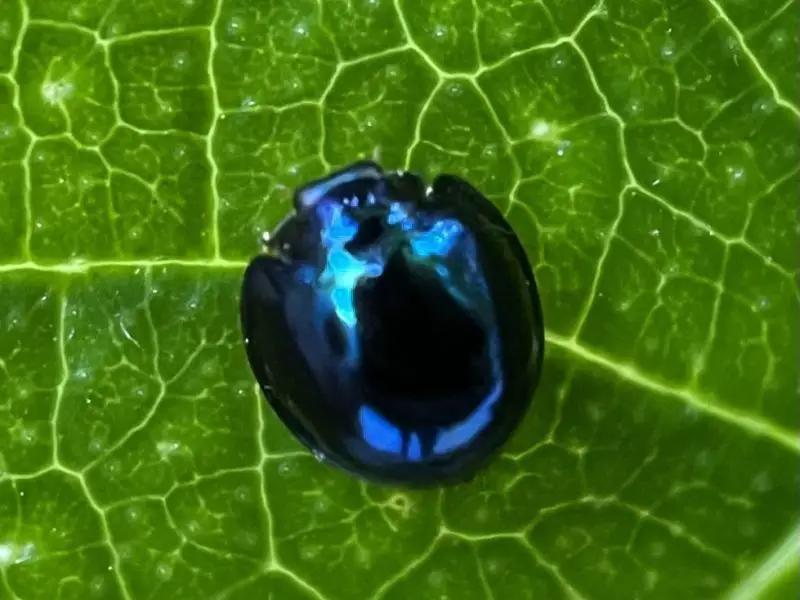
The Steelblue Lady Beetle is one of the most visually captivating ladybugs in Florida. Its small, round body shines with a metallic blue or bluish-green sheen that almost looks iridescent in sunlight. Unlike the familiar red-and-black species, this beetle’s polished, uniform coloration gives it an elegant, jewel-like appearance. It measures about 3–4 millimeters in length.
Native to Australia, it was introduced to several countries, including the United States, for biological pest control. In Florida, it thrives particularly well in the southern regions, where the warm, humid climate supports its preferred prey—soft scales and aphids. It’s often found on fruit trees, ornamental plants, and tropical vegetation.
Both adult and larval Steelblue Lady Beetles specialize in feeding on soft scale insects, which are common pests in citrus orchards. They also consume mealybugs and other sap-sucking pests that weaken trees. Their feeding activity helps improve plant health and productivity, making them highly valued among growers and horticulturists.
This species’ metallic sheen is not just beautiful—it also provides subtle camouflage among glossy leaves and bark. The Steelblue Lady Beetle is active year-round in Florida’s tropical and subtropical zones, often appearing in clusters on infested trees. Its combination of beauty, efficiency, and ecological importance makes it a standout among Florida’s diverse ladybug fauna.
Multicolored Lady Beetle (Harmonia quadripunctata)
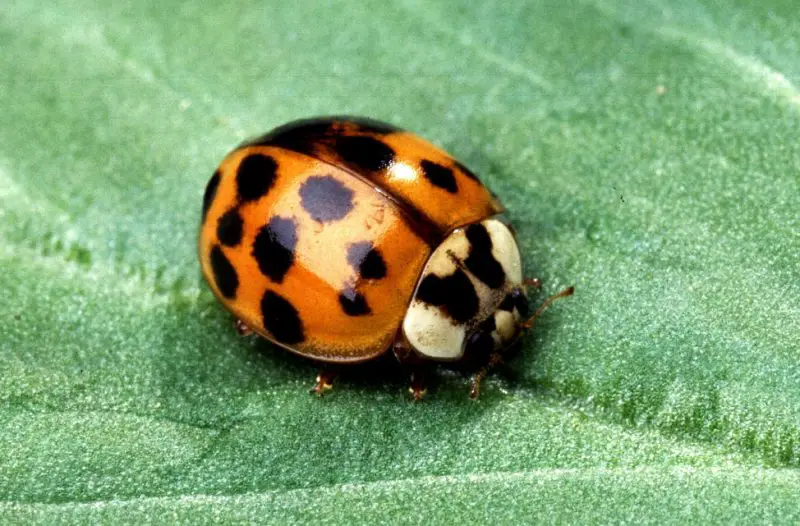
The Multicolored Lady Beetle is a lesser-known but fascinating member of Florida’s ladybug population. It exhibits a wide range of color variations, from vivid red-orange to light brown or even golden hues. Typically, it displays four faint black spots on its wing covers, though some individuals may appear spotless. Slightly smaller and less dome-shaped than other Harmonia species, it has a more elongated body that gives it a sleek, aerodynamic appearance.
This species is native to Europe but has adapted well to subtropical climates, including many regions of Florida. It thrives in mixed habitats—woodland edges, meadows, and gardens—where vegetation is dense and pest populations are abundant. In Florida, the Multicolored Lady Beetle is most active during spring and fall, when temperatures are mild and prey is plentiful.
Like most ladybugs, it is a skilled predator of plant-damaging insects. Its diet mainly consists of aphids, small caterpillars, and insect eggs found on shrubs and flowering plants. Both adult beetles and larvae consume large quantities of pests, making them a valuable part of Florida’s natural pest management system.
Although not as common or widespread as the Asian Lady Beetle, the Multicolored Lady Beetle plays a subtle yet important role in maintaining ecological balance. Its adaptability to different habitats and color variability make it a unique representative of the Harmonia genus. In Florida’s diverse ecosystems, it contributes quietly but effectively to plant health and pest control.
Twenty-Spotted Lady Beetle (Psyllobora vigintimaculata)
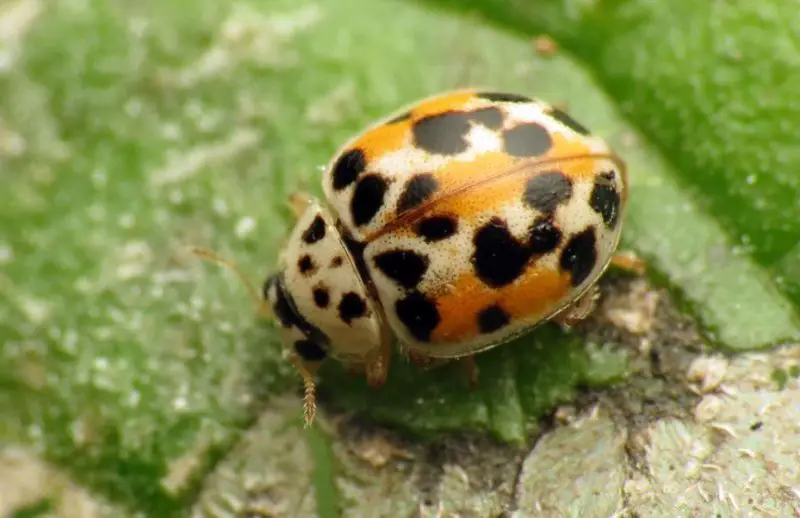
The Twenty-Spotted Lady Beetle is one of Florida’s most delicate and easily overlooked ladybug species. Tiny in size—only about 3 to 4 millimeters long—it features a pale creamy-yellow or whitish body adorned with twenty distinct black spots. Its compact, oval shape and subtle color make it look quite different from the more vividly colored red-and-black ladybugs that most people recognize.
This species can be found throughout Florida, particularly in damp or shaded environments where fungus thrives. Typical habitats include woodland edges, shaded gardens, forest floors, and areas rich in decaying plant matter. It’s especially common during humid months when fungal growth increases, providing ample food sources.
Unlike most ladybugs that feed on insect pests, the Twenty-Spotted Lady Beetle has a specialized diet. It feeds on powdery mildew fungi found on the surfaces of leaves, stems, and other plant parts. Both the adult beetles and their larvae scrape the fungal coating off leaves, helping to control fungal spread naturally without damaging plants.
Though it isn’t a predator of aphids or scales, the Twenty-Spotted Lady Beetle plays a crucial role in maintaining plant health. By consuming powdery mildew, it reduces the impact of fungal diseases on ornamental and native plants alike. Its presence in Florida gardens and forests serves as a natural indicator of ecological balance and environmental cleanliness.
FAQs About Ladybugs in Florida
Are ladybugs beneficial in Florida gardens?
Yes, ladybugs are among the most beneficial insects in Florida. Most species feed on aphids, whiteflies, and scale insects, providing natural pest control and reducing the need for chemical sprays.
Do ladybugs bite or harm humans?
Ladybugs are harmless to humans. However, the Asian Lady Beetle (Harmonia axyridis) may occasionally pinch skin if handled, though it doesn’t transmit disease or cause injury.
What attracts ladybugs to Florida homes?
Ladybugs, especially the Asian Lady Beetle, often seek shelter indoors during cooler months or heavy rains. They’re drawn to light-colored walls and warm environments.
How can I attract ladybugs to my garden?
Planting nectar-rich flowers such as dill, fennel, and marigolds helps attract ladybugs. Avoid using pesticides, which can kill both ladybugs and their prey.
Are all ladybugs in Florida red with black spots?
No — ladybugs in Florida come in a wide range of colors including yellow, orange, pink, brown, gray, and even metallic blue. Some have no spots, while others have more than twenty.

